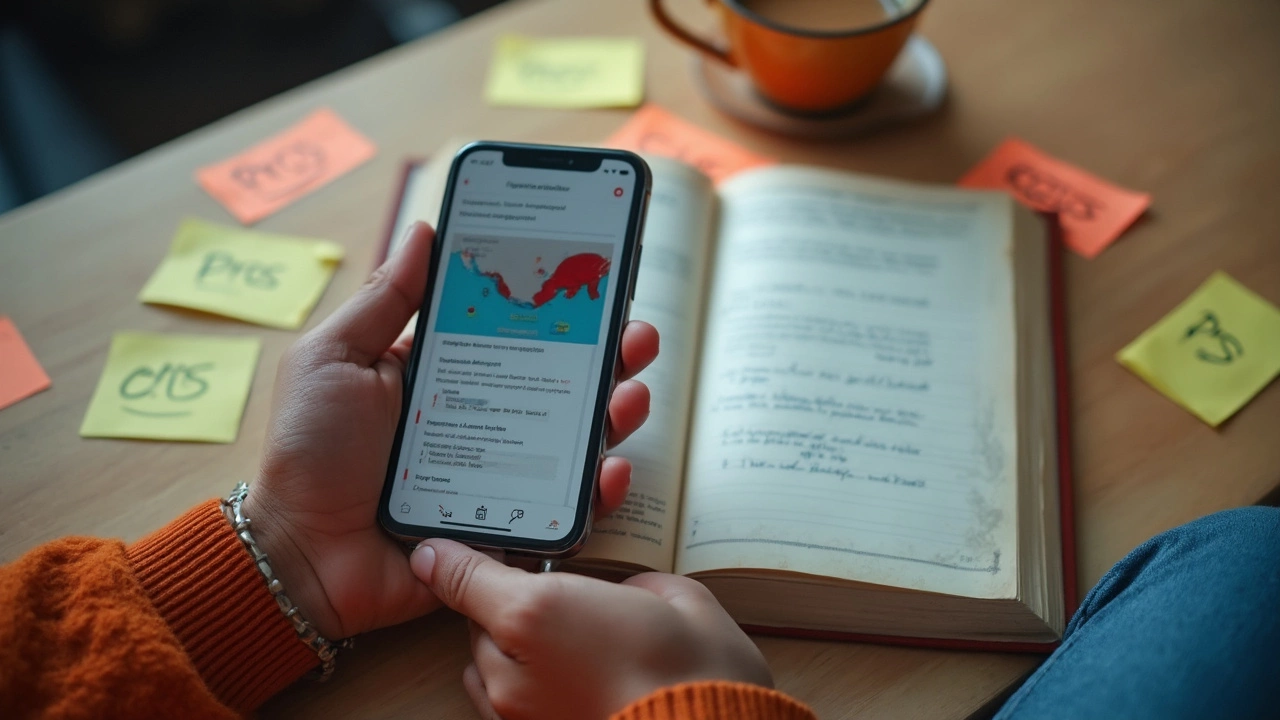People throw around all sorts of advice about learning English—some swear by flashy apps, others insist nothing beats a classroom. Truth is, the best tool isn’t always what’s newest or most popular. It’s what helps you actually speak and understand real English in real life.
Think about this: over 1.5 billion people are trying to learn English right now. That means the "best" tool for you might not be the same for your neighbor, your cousin, or the guy in your daily Zoom meeting. Finding the right fit matters way more than following the crowd.
If you want to actually use English—not just memorize words—then how you practice is just as important as what you practice with. Some people never get past textbook sentences; others pick up slang from memes but struggle to hold a basic conversation. It's about making smart choices on tools that push you to listen, speak, and think in English, not just fill in blanks or watch endless grammar videos.
- Why Choosing the Right Tool Matters
- Apps vs. Traditional Courses: The Real Differences
- How Speaking Practice Changes the Game
- Hidden Factors That Speed Up Learning
- Tips to Stick With Your Choice and Get Results
Why Choosing the Right Tool Matters
Picking the best tool to learn English isn’t just about saving time. It’s about whether you actually make progress or get stuck repeating the same mistakes. If you’ve ever signed up for a course or app and then stopped using it after a week, you know what I mean.
Here’s one hard fact: according to a 2023 study from Cambridge University, language learners who used a tool tailored to their goals stuck with it 40% longer than those who used random apps or courses. That’s a huge jump just from finding a good match.
Everyone learns differently. Some people pick things up by listening, others by reading or doing. So if your tool of choice doesn’t match your learning style, you’re probably going to get bored—or worse, frustrated enough to quit. On the other hand, a great tool lets you:
- Practice speaking English so you’re not just a pro at filling in grammar exercises.
- Hear real conversations, not just scripted dialogues that nobody actually uses in daily life.
- Get feedback right away, so you can fix mistakes before they become habits.
Your goals matter too. Are you looking to ace a test, crush a job interview, or just chat with friends comfortably? The "right" English speaking course for passing an exam isn’t always great for everyday conversation—and vice versa.
If you’re curious about what keeps people on track, check out this quick comparison:
| Tool Type | Average Retention Rate | Best For |
|---|---|---|
| App (like Duolingo) | 20% | Vocabulary, quick lessons |
| In-person Course | 60% | Interactive practice, feedback |
| Online Speaking Platform | 70% | Conversation skills, real use |
The numbers show that when people use a tool that pushes them to speak and interact, they stick with it more. That’s not a coincidence. It’s proof that choosing the right tool can make or break your English learning journey.
Apps vs. Traditional Courses: The Real Differences
Picking a learn English method usually comes down to a classic face-off: modern apps or traditional classes. Both options can help you, but they go about it in totally different ways.
Let’s break it down—apps are everywhere right now. You’ve probably heard of Duolingo, Babbel, or Memrise. These language learning apps nail convenience. You can practice for five minutes in line or on the bus. That’s huge for busy people. Some apps also use gamification, so you rack up points as you go. It feels less like homework, more like playing a game. A 2023 survey showed that 62% of beginner English learners opened their app at least three times a week.
But—and it’s a big but—speaking real English isn’t just about matching words on a screen. Apps can get you started with basics and vocab, but they don’t always help you think on your feet in an actual conversation. And your pronunciation? Unless you’re using an app with live interaction, you don’t get much feedback.
Now, let’s talk about English speaking courses in the classroom or online. These are old-school for a reason: you get structure, actual teachers, and usually classmates to talk to. Real speaking practice is baked in. Plus, teachers can correct your mistakes on the spot. Some even follow proven curriculums from Cambridge or Oxford. There’s a reason 80% of advanced English speakers have taken at least one formal course in their life—actual conversations and guidance make a difference.
But courses aren’t perfect. They often cost more than an app—sometimes way more. You have to show up at certain times, which doesn’t fit everyone’s schedule. And let’s face it, sometimes classes can move too fast or too slow, depending on your level.
| Feature | Apps | Traditional Courses |
|---|---|---|
| Flexibility | High (anytime, anywhere) | Low (set schedule) |
| Speaking Practice | Limited unless app has live chat | High (group work, teacher feedback) |
| Cost | Usually free or cheap | Often more expensive |
| Motivation | Gamified, short bursts | Personal accountability, peer pressure |
The bottom line? If you’re just starting your English speaking journey and want something casual, apps are a solid way in. If you want real improvement—especially in speaking and understanding fast English—traditional classes, even the online versions, push you further. The sweet spot for a lot of people is combining both: an app for daily practice and a course when you’re ready to get more serious.

How Speaking Practice Changes the Game
You can read all the textbooks, binge on grammar videos, and master every multiple-choice quiz, but if you never try to actually talk, learning slows way down. The act of speaking – even if it’s just with a language partner online or talking to yourself – rewires how fast you pick up real, everyday English.
Here’s something to think about: learners who do regular speaking practice build confidence up to 50% faster than those stuck in silent drills. When you force your brain to come up with sentences in real time, it’s closer to the way kids learn. Mistakes happen, you get flustered, but your brain learns what works way better than by just memorizing rules.
Some popular English speaking courses have built-in speaking clubs, voice chats, or live classes. There are even apps that use artificial intelligence to correct your accent or grammar in real time. This isn’t just high-tech hype—the more you actually talk, the more your listening goes up too. You start to catch slang, intonation, and the speed real people use.
| Practice Method | Retention Rate (%) |
|---|---|
| Reading Only | 30 |
| Writing Only | 40 |
| Speaking & Listening | 70 |
That’s why people in immersive environments—study abroad, living in an English-speaking city, chatting daily with a native—usually learn faster, even if their grammar isn’t perfect. But you don’t have to travel to get this effect. Try these:
- Join an online conversation group (even 1-on-1 video calls count).
- Record yourself and play it back—cringey, but super helpful.
- Sneak English into your day: order food, ask for directions, or even just talk to your pet.
- Apps like HelloTalk and Tandem connect you with real speakers for free practice.
The point isn’t sounding perfect. It’s getting comfortable thinking and responding in English without freezing up. Real progress comes when you stop worrying about every single mistake and start focusing on being understood.
Hidden Factors That Speed Up Learning
Most people think learning English is just about nailing vocabulary or finishing grammar exercises. That’s only half the picture. There are hidden details that can make a huge difference—details even the top English speaking courses sometimes skip over.
Let’s get real: habits outside the classroom matter a ton. For example, the European Commission did a study that showed students who used English for just 10 minutes a day, even outside of class, picked up the language way faster than their classmates who only studied in lessons.
Some lesser-known factors work like hidden boosters:
- Consistency over intensity: Practicing for 15 minutes every day beats cramming for three hours once a week. This forces your brain to keep coming back to English, making it “stick” better.
- Real-life use beats drills: Ordering coffee, chatting online, or even narrating what you’re doing in English cements skills faster than filling out worksheets. It tricks your brain into thinking English is actually useful—not just schoolwork.
- Mixing input types: Listen to music, watch YouTube, read memes, text your friends—combining apps and real talk uses all parts of your brain. A 2023 report from Duolingo even found people who used at least two types of tools (like an app and movies) jumped levels 25% faster than single-tool learners.
- Safe mistakes: You’ll learn twice as fast if you’re not afraid to mess up. Trying and failing—and hearing corrections—reprograms your brain faster than never talking at all. Look for English speaking courses where you can make mistakes without getting embarrassed.
Check out this quick breakdown to see what really speeds up learning:
| Factor | Boost to Progress |
|---|---|
| Daily Practice | +36% faster improvement |
| Multiple Input Types | +25% faster level jump |
| Speaking Without Fear | +2x retention |
If you focus on these areas—not just another app or textbook—you’ll notice changes way sooner. Don’t worry so much about being perfect. Just keep showing up, mixing it up, and putting yourself out there. Learn English by making it part of your life, not separate homework.

Tips to Stick With Your Choice and Get Results
It’s way too easy to sign up for a learn English app, do a few lessons, and just quit. Sticking with your tool is honestly half the battle, but it gets a lot easier when you use some simple tricks that are backed by research and actually work in the real world.
First, set super clear and realistic goals. A group of students in a Cambridge study who set weekly speaking goals improved twice as fast as students who stuck to vague “study more” promises. Don’t just hope you’ll "get better" at English—decide what “better” really means to you. Is it being able to order at a restaurant confidently? Nailing a job interview? Make it specific!
- Schedule actual time for your English speaking courses and practice. Put it in your phone’s calendar and set reminders. Treat it like you’d treat a gym workout or meeting—non-negotiable.
- Mix it up. If you get bored with one tool, add something new for a week. Listen to a podcast, play a vocabulary game, or chat with someone online. Variety keeps your brain engaged.
- Track your progress. Almost every top English learning app has progress stats—use them! If your tool doesn’t, keep a notepad or checklist and mark off days you study or words you master. Tiny wins keep you motivated.
- Get some social pressure. Tell a friend about your goal, or better yet, find a buddy who’s learning too. Just knowing someone might ask you how it’s going pushes you to show up.
- Reward yourself for sticking with it. Land up four practice sessions this week? Treat yourself to a snack or a favorite show.
Here’s one more thing: Don’t ignore setbacks. A study from Harvard found most language learners miss their weekly target at least twice a month, but the ones who kept going saw the biggest jumps in fluency. If you miss a day (or five), don’t sweat it—just get back on track.
| Habit | Chance of Sticking 1 Month+ |
|---|---|
| Study with scheduled reminders | 82% |
| No reminders, random study times | 37% |
| Learning with a buddy or group | 71% |
Picking the best tool is huge, but the real win is finding ways to make learning a part of your daily life—no matter what craziness your week throws at you. Get a routine that fits, keep things interesting, and brag about your goals to someone. That’s how people actually see results with English.



